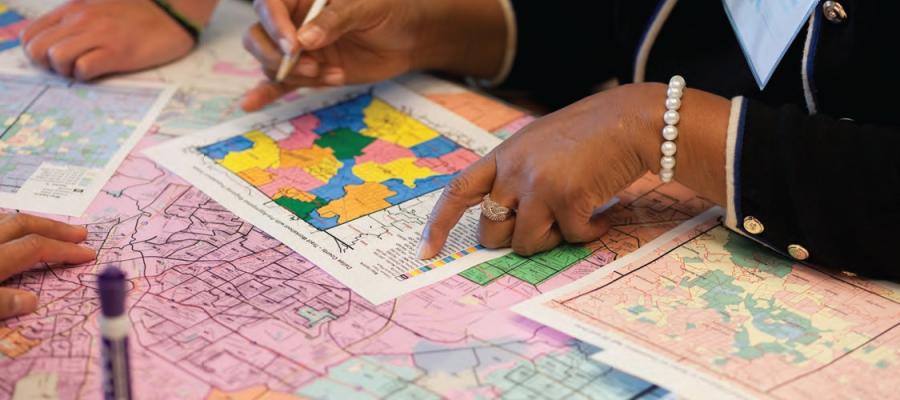June 12, 2013

Report Cites Successes and Difficulties for the Commission and Strategies for Ensuring
that Future Commissions are Successful.
Sacramento, CA – A new, independent report, entitled “When the People Draw the Lines,” finds that California’s first Citizens Redistricting Commission (CRC) successfully drew district lines in a transparent, democratic and nonpartisan fashion that earned wide public support. Among the estimated one third of voters who were familiar with the work of the commission, 66% approved of the maps drawn by the CRC. The report also identified issues to address before the next redistricting process takes place.
“Over the last decade, we have seen California’s citizens wrestle power away from legislators and take active steps to be more fully engaged in the state’s democracy,” said Jennifer Waggoner, President of the League of Women Voters of California. “For us, the report’s findings show that the most recent line-drawing process was a big step in the right direction. At the same time, there is still more we can do to help support future commissions and to prepare California citizens for fuller participation,” she added.
The report, researched and written by Raphael J. Sonenshein, Ph.D. , with the help of four research consultants, and commissioned by the League of Women Voters of California (LWVC) in partnership with The James Irvine Foundation, examines whether the CRC effectively engaged California communities in the process of redrawing Assembly, Senate, Board of Equalization, and Congressional district lines. It provides an unbiased, thoroughly researched analysis of where the Citizens Redistricting Commission succeeded and where it could have been more successful. The report also identifies the steps necessary to ensure success for future redistricting commissions.
After the passage of Prop 11 in 2008 and Prop 20 in 2010, the California Bureau of State Audits (BSA) began the process to create a Citizens Redistricting Commission to guide an independent redistricting process. The 14-person commission was given the complex task of redrawing 177 districts in only eight months.
The League cited the following positive, compelling findings identified within the report :
- Citizen redistricting provided an opportunity for all Californians to stand up and express their viewpoints on how to select commissioners as well as how to draw district lines.
- Commissioners actively and deliberately sought input of the public through public meetings, open databases, and online engagement.
- Among the estimated 1/3 of the voters who were familiar with the work of the commission, 66% approved of the CRC district maps.
- The commission’s maps survived strenuous legal challenges, with no adverse court decisions.
While Dr. Sonenshein, the Executive Director of the Pat Brown Institute of Public Affairs at Cal State Los Angeles, identified these positive achievements by the CRC, he also cites instances where the commission suffered from a lack of time and monetary and structural support.
- While the BSA had over two years to structure and execute the commissioner selection process, the CRC was only given eight months to redraw district lines and solicit public input.
- Once the CRC did begin the mapping process, the commissioners suffered lengthy delays in producing maps and public outreach. Notably, the commission had only two months to share draft maps with the public and incorporate public feedback.
- The CRC lacked funding for outreach and engagement with the public, which meant they had to rely on partner organizations and reserve funds for approximately $13 million in funding.
“Despite some of the challenges,” said Dr. Sonenshein, “citizen redistricting achieved a goal that was consistent with the spirit of the laws passed by voters: shaking up the incumbent-centered world of California politics.”
The League of Women Voters of California and their many partners hope to use the report findings to begin addressing some of the obstacles that may damage the work of future redistricting commissions.
“This new report is a valuable contribution to the dialogue of how citizen-led redistricting can be supported and the importance of engaging all citizens in the complete redistricting process,” stated Michelle DiGuilo, a member of the first California Citizens Redistricting Commission. “I’m excited to work with others to identify the best practices that can guide future commissions in addressing the opportunities and challenges in citizen-led redistricting efforts,” she added.
The League will especially focus on preparing communities across the state for fuller engagement during the next redistricting process. They will also continue to be vigilant regarding laws and ballot measures that directly seek to damage or eliminate the Citizens Redistricting Commission or that target the work already performed by the commission. Finally, they hope leaders in the state thoughtfully review the report and use the findings to inform how they prepare for future commissions.
To read “When the People Draw the Lines,” please visit: http://cavotes.org/redistrictingreport.
Contact: Edit Ruano, Full Court Press Communications O: 510-550-8176; C: 530-305-9427
# # #
About the League of Women Voters of California (LWVC): The League is a nonpartisan political organization for women and men that encourages informed and active participation in government and influences public policy through education and advocacy. LWVC does not support or oppose any political party or any candidate.
More information on the League can be found at: http://lwvc.org/.
Subject
New Report Examines Whether California Citizens Redistricting Commission Was Transparent and Democratic in Drawing District Lines


